Research of the Energy Losses of Photovoltaic (PV) Modules after Hail Simulation Using a Newly-Created Testbed
Abstract
1. Introduction
2. Hail Simulation Testbed and Equipment for Measuring Dynamic Parameters
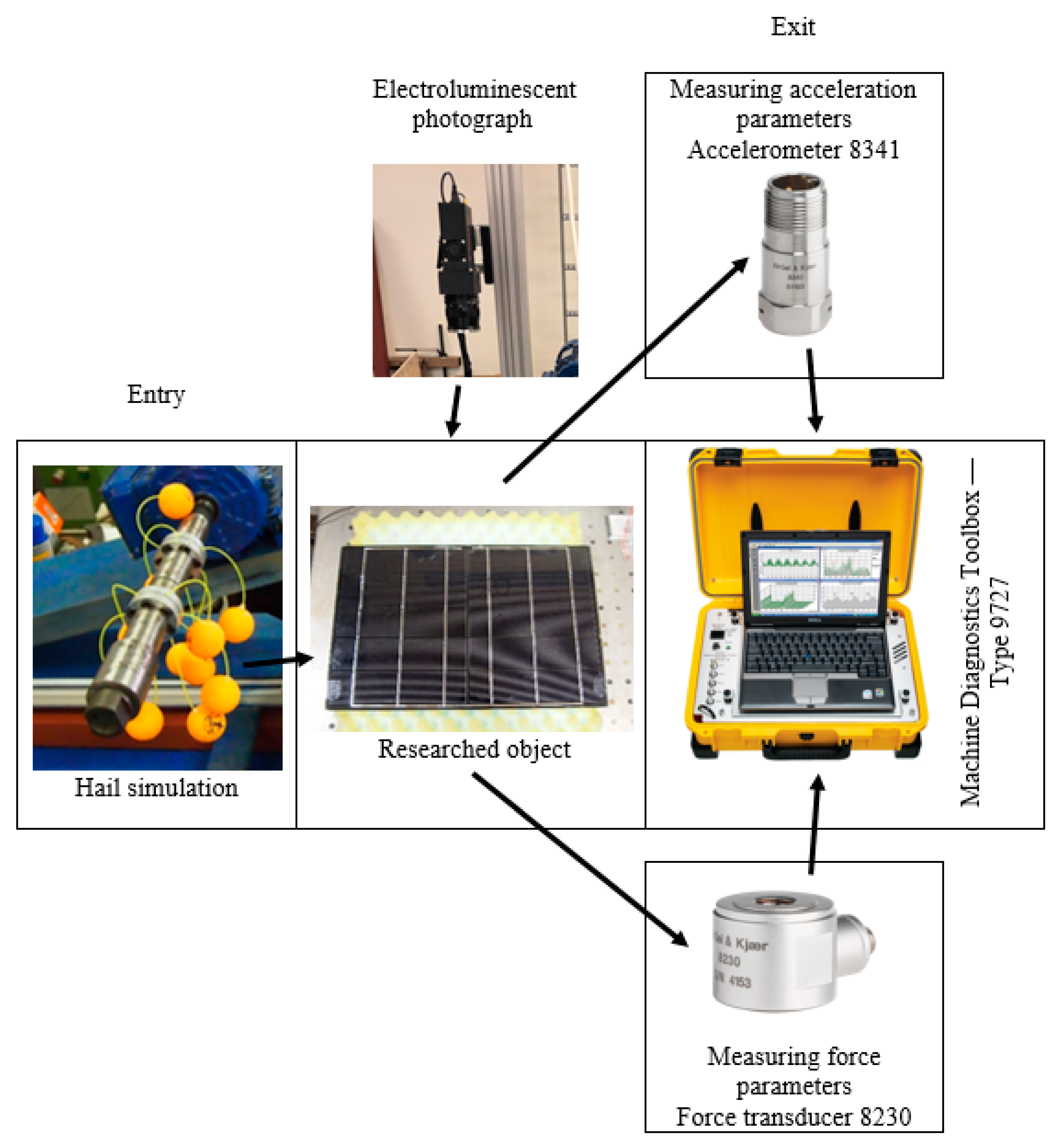
3. Experimental and Theoretical Research Results
4. Research of the Resistance of Photovoltaic Modules
5. Conclusions
Author Contributions
Funding
Conflicts of Interest
References
- Buerhop, C.; Wirsching, S.; Bemm, A.; Pickel, T.; Hohmann, P.; Nieß, M.; Vodermayer, C.; Huber, A.; Glück, B.; Mergheim, J.; et al. Evolution of cell cracks in PV-modules under field and laboratory conditions. Prog. Photovolt. Res. Appl. 2018, 26, 261–272. [Google Scholar] [CrossRef]
- Camus, C.; Offermann, P.; Weissmann, M.; Buerhop, C.; Hauch, J.; Brabec, C.J. Site-specific assessment of mechanical loads on photovoltaic modules from meteorological reanalysis data. Sol. Energy 2019, 188, 1134–1145. [Google Scholar] [CrossRef]
- Lillo-Bravo, I.; González-Martínez, P.; Larrañeta, M.; Guasumba-Codena, J. Impact of Energy Losses Due to Failures on Photovoltaic Plant Energy Balance. Energies 2018, 11, 363. [Google Scholar] [CrossRef]
- Rendler, L.C.; Romer, P.; Beinert, A.J.; Walter, J.; Stecklum, S.; Kraft, A.; Eitner, U.; Wiese, S. Thermomechanical stress in solar cells: Contact pad modeling and reliability analysis. Sol. Energy Mater. Sol. Cells 2019, 196, 167–177. [Google Scholar] [CrossRef]
- Corrado, M.; Infuso, A.; Paggi, M. Simulated hail impacts on flexible photovoltaic laminates: Testing and modelling. Meccanica 2017, 52, 1425–1439. [Google Scholar] [CrossRef]
- Beinert, A.J.; Ebert, M.; Eitner, U.; Aktaa, J. Influence of Photovoltaic Module Mounting Systems on the Thermo-Mechanical Stresses in Solar Cells by FEM Modelling. In Proceedings of the 32nd European Photovoltaic Solar Energy Conference and Exhibition, Munich, Germany, 20–24 June 2016; pp. 1833–1836. [Google Scholar]
- Tippabhotla, S.K.; Radchenko, I.; Song, W.J.R.; Illya, G.; Handara, V.; Kunz, M.; Tamura, N.; Tay, A.A.O.; Budiman, A.S. From cells to laminate: Probing and modeling residual stress evolution in thin silicon photovoltaic modules using synchrotron X-ray micro-diffraction experiments and finite element simulations: Probing and modeling residual stress evolution. Prog. Photovolt. Res. Appl. 2017, 25, 791–809. [Google Scholar] [CrossRef]
- Višniakov, N.; Kilikevičius, A.; Novickij, J.; Grainys, A.; Novickij, V. Low-cost experimental facility for evaluation of the effect of dynamic mechanical loads on photovoltaic modules. Eksploat. Niezawodn. Maint. Reliab. 2015, 17, 334–337. [Google Scholar] [CrossRef]
- Kilikevičius, A.; Čereška, A.; Kilikevičienė, K. Analysis of external dynamic loads influence to photovoltaic module structural performance. Eng. Fail. Anal. 2016, 66, 445–454. [Google Scholar] [CrossRef]
- Martins, A.C.; Chapuis, V.; Virtuani, A.; Li, H.-Y.; Perret-Aebi, L.-E.; Ballif, C. Thermo-mechanical stability of lightweight glass-free photovoltaic modules based on a composite substrate. Sol. Energy Mater. Sol. Cells 2018, 187, 82–90. [Google Scholar] [CrossRef]
- Kilikevičienė, K.; Matijošius, J.; Fursenko, A.; Kilikevičius, A. Tests of hail simulation and research of the resulting impact on the structural reliability of solar cells. Ekspolatacja Niezawodn. Maint. Reliab. 2019, 21, 275–281. [Google Scholar] [CrossRef]
- Paggi, M.; Corrado, M.; Berardone, I. A global/local approach for the prediction of the electric response of cracked solar cells in photovoltaic modules under the action of mechanical loads. Eng. Fract. Mech. 2016, 168, 40–57. [Google Scholar] [CrossRef]
- Di Giacomo, F.; Fakharuddin, A.; Jose, R.; Brown, T.M. Progress, challenges and perspectives in flexible perovskite solar cells. Energy Environ. Sci. 2016, 9, 3007–3035. [Google Scholar] [CrossRef]
- Said, S.A.M.; Hassan, G.; Walwil, H.M.; Al-Aqeeli, N. The effect of environmental factors and dust accumulation on photovoltaic modules and dust-accumulation mitigation strategies. Renew. Sustain. Energy Rev. 2018, 82, 743–760. [Google Scholar] [CrossRef]
- Eisenträger, J.; Naumenko, K.; Altenbach, H.; Köppe, H. Application of the first-order shear deformation theory to the analysis of laminated glasses and photovoltaic panels. Int. J. Mech. Sci. 2015, 96, 163–171. [Google Scholar] [CrossRef]
- Bouraiou, A.; Hamouda, M.; Chaker, A.; Mostefaoui, M.; Lachtar, S.; Sadok, M.; Boutasseta, N.; Othmani, M.; Issam, A. Analysis and evaluation of the impact of climatic conditions on the photovoltaic modules performance in the desert environment. Energy Convers. Manag. 2015, 106, 1345–1355. [Google Scholar] [CrossRef]
- Ndiaye, A.; Kébé, C.M.F.; Charki, A.; Ndiaye, P.A.; Sambou, V.; Kobi, A. Degradation evaluation of crystalline-silicon photovoltaic modules after a few operation years in a tropical environment. Sol. Energy 2014, 103, 70–77. [Google Scholar] [CrossRef]
- Kichou, S.; Silvestre, S.; Nofuentes, G.; Torres-Ramírez, M.; Chouder, A.; Guasch, D. Characterization of degradation and evaluation of model parameters of amorphous silicon photovoltaic modules under outdoor long term exposure. Energy 2016, 96, 231–241. [Google Scholar] [CrossRef]
- Punge, H.J.; Kunz, M. Hail observations and hailstorm characteristics in Europe: A review. Atmospheric Res. 2016, 176–177, 159–184. [Google Scholar] [CrossRef]
- Guo, B.; Javed, W.; Pett, C.; Wu, C.-Y.; Scheffe, J.R. Electrodynamic dust shield performance under simulated operating conditions for solar energy applications. Sol. Energy Mater. Sol. Cells 2018, 185, 80–85. [Google Scholar] [CrossRef]
- Du, B.; Yang, R.; He, Y.; Wang, F.; Huang, S. Nondestructive inspection, testing and evaluation for Si-based, thin film and multi-junction solar cells: An overview. Renew. Sustain. Energy Rev. 2017, 78, 1117–1151. [Google Scholar] [CrossRef]
- International Electrotechnical Commission. Technical Committee 82: Solar Photovoltaic Energy Systems. In Modules photovoltaïques (PV) au silicium cristallin pour application terrestre: Qualification de la conception et homologation = Crystalline Silicon Terrestrial Photovoltaic (PV) Modules: Design Qualification and Type Approval; International Electrotechnical Commission: Geneva, Switzerland, 2005; ISBN 978-2-8318-7963-5. [Google Scholar]
- Kraemer, F.; Wiese, S.; Peter, E.; Seib, J. Mechanical problems of novel back contact solar modules. Microelectron. Reliab. 2013, 53, 1095–1100. [Google Scholar] [CrossRef]
- Nikoletatos, J.; Halambalakis, G. Standards, Calibration, and Testing of PV Modules and Solar Cells. In McEvoy’s Handbook of Photovoltaics; Elsevier: Chennai, India, 2018; pp. 1155–1182. ISBN 978-0-12-809921-6. [Google Scholar]
- Osterwald, C.R. Standards, Calibration, and Testing of PV Modules and Solar Cells. In Practical Handbook of Photovoltaics; Elsevier: Waltham, MA, USA, 2012; pp. 1045–1069. ISBN 978-0-12-385934-1. [Google Scholar]
- Perera, S.; Lam, N.; Pathirana, M.; Zhang, L.; Ruan, D.; Gad, E. Use of static tests for predicting damage to cladding panels caused by storm debris. J. Build. Eng. 2017, 12, 109–117. [Google Scholar] [CrossRef]
- Pernas-Sánchez, J.; Artero-Guerrero, J.A.; López-Puente, J.; Varas, D. Numerical methodology to analyze the ice impact threat: Application to composite structures. Mater. Des. 2018, 141, 350–360. [Google Scholar] [CrossRef]
- Sohel, K.M.A.; Richard Liew, J.Y.; Koh, C.G. Numerical modelling of lightweight Steel-Concrete-Steel sandwich composite beams subjected to impact. Thin Walled Struct. 2015, 94, 135–146. [Google Scholar] [CrossRef]
- Zhang, D.; Fei, Q.; Zhang, P. Drop-weight impact behavior of honeycomb sandwich panels under a spherical impactor. Compos. Struct. 2017, 168, 633–645. [Google Scholar] [CrossRef]
- Selech, J.; Joachimiak-Lechman, K.; Klos, Z.; Kulczycka, J.; Kurczewski, P. Life cycle thinking in small and medium enterprises: The results of research on the implementation of life cycle tools in Polish SMEs—Part 3: LCC-related aspects. Int. J. Life Cycle Assess. 2014, 19, 1119–1128. [Google Scholar] [CrossRef]
- Andrzejczak, K.; Młyńczak, M.; Selech, J. Poisson-distributed failures in the predicting of the cost of corrective maintenance. Eksploat. Niezawodn.Maint. Reliab. 2018, 20, 602–609. [Google Scholar] [CrossRef]
- Roy, S.; Kumar, S.; Gupta, R. Investigation and analysis of finger breakages in commercial crystalline silicon photovoltaic modules under standard thermal cycling test. Eng. Fail. Anal. 2019, 101, 309–319. [Google Scholar] [CrossRef]
- Ceran, B.; Orłowska, A. The Impact of Power Source Performance Decrease in a PV/WT/FC Hybrid Power Generation System on the Result of a Multi-Criteria Analysis of Load Distribution. Energies 2019, 12, 3453. [Google Scholar] [CrossRef]
- Song, Z.; Le, J.; Whisler, D.; Kim, H. Skin-stringer interface failure investigation of stringer-stiffened curved composite panels under hail ice impact. Int. J. Impact Eng. 2018, 122, 439–450. [Google Scholar] [CrossRef]
- Cha, H.; Bhang, B.; Park, S.; Choi, J.; Ahn, H. Power Prediction of Bifacial Si PV Module with Different Reflection Conditions on Rooftop. Appl. Sci. 2018, 8, 1752. [Google Scholar] [CrossRef]
- Beinert, A.J.; Büchler, A.; Romer, P.; Haueisen, V.; Rendler, L.C.; Schubert, M.C.; Heinrich, M.; Aktaa, J.; Eitner, U. Enabling the measurement of thermomechanical stress in solar cells and PV modules by confocal micro-Raman spectroscopy. Sol. Energy Mater. Sol. Cells 2019, 193, 351–360. [Google Scholar] [CrossRef]
- Boumaaraf, B.; Boumaaraf, H.; Slimani, M.E.-A.; Tchoketch_Kebir, S.; Ait-cheikh, M.S.; Touafek, K. Performance evaluation of a locally modified PV module to a PV/T solar collector under climatic conditions of semi-arid region. Math. Comput. Simul. 2020, 167, 135–154. [Google Scholar] [CrossRef]
- Ozden, T.; Carr, A.J.; Geerligs, B.L.; Turan, R.; Akinoglu, B.G. One-year performance evaluation of two newly developed back-contact solar modules in two different climates. Renew. Energy 2020, 145, 557–568. [Google Scholar] [CrossRef]
- Devadhas, G.G. Design and development of new control technique for standalone PV system. Microprocess. Microsyst. 2020, 72, 102888. [Google Scholar]
- Orioli, A. An accurate one-diode model suited to represent the current-voltage characteristics of crystalline and thin-film photovoltaic modules. Renew. Energy 2020, 145, 725–743. [Google Scholar] [CrossRef]
- Thormeyer, C.; Sasse, J.-P.; Trutnevyte, E. Spatially-explicit models should consider real-world diffusion of renewable electricity: Solar PV example in Switzerland. Renew. Energy 2020, 145, 363–374. [Google Scholar] [CrossRef]
- Fathabadi, H. Novel solar-powered photovoltaic/thermoelectric hybrid power source. Renew. Energy 2020, 146, 426–434. [Google Scholar] [CrossRef]
- Jendoubi, A.; Tlili, F.; Bacha, F. Sliding mode control for a grid connected PV-system using interpolation polynomial MPPT approach. Math. Comput. Simul. 2020, 167, 202–218. [Google Scholar] [CrossRef]
- Gürtürk, M.; Benli, H.; Ertürk, N.K. Determination of the effects of temperature changes on solar glass used in photovoltaic modules. Renew. Energy 2020, 145, 711–724. [Google Scholar] [CrossRef]
- Liu, D.; Sun, Y.; Wilson, R.; Wu, Y. Comprehensive evaluation of window-integrated semi-transparent PV for building daylight performance. Renew. Energy 2020, 145, 1399–1411. [Google Scholar] [CrossRef]
- Mundaca, L.; Samahita, M. What drives home solar PV uptake? Subsidies, peer effects and visibility in Sweden. Energy Res. Soc. Sci. 2020, 60, 101319. [Google Scholar] [CrossRef]
- Klugmann-Radziemska, E.; Kuczyńska-Łażewska, A. The use of recycled semiconductor material in crystalline silicon photovoltaic modules production—A life cycle assessment of environmental impacts. Sol. Energy Mater. Sol. Cells 2020, 205, 110259. [Google Scholar] [CrossRef]
- Castro, L.M.; Rodríguez-Rodríguez, J.R.; Martin-del-Campo, C. Modelling of PV systems as distributed energy resources for steady-state power flow studies. Int. J. Electr. Power Energy Syst. 2020, 115, 105505. [Google Scholar] [CrossRef]
- Manohar, M.; Koley, E.; Ghosh, S.; Mohanta, D.K.; Bansal, R.C. Spatio-temporal information based protection scheme for PV integrated microgrid under solar irradiance intermittency using deep convolutional neural network. Int. J. Electr. Power Energy Syst. 2020, 116, 105576. [Google Scholar] [CrossRef]
- Tsai, C.-Y.; Tsai, C.-Y. See-through, light-through, and color modules for large-area tandem amorphous/microcrystalline silicon thin-film solar modules: Technology development and practical considerations for building-integrated photovoltaic applications. Renew. Energy 2020, 145, 2637–2646. [Google Scholar] [CrossRef]
- Obiwulu, A.U.; Chendo, M.A.C.; Erusiafe, N.; Nwokolo, S.C. Implicit meteorological parameter-based empirical models for estimating back temperature solar modules under varying tilt-angles in Lagos, Nigeria. Renew. Energy 2020, 145, 442–457. [Google Scholar] [CrossRef]
- Hassan, A.; Wahab, A.; Qasim, M.A.; Janjua, M.M.; Ali, M.A.; Ali, H.M.; Jadoon, T.R.; Ali, E.; Raza, A.; Javaid, N. Thermal management and uniform temperature regulation of photovoltaic modules using hybrid phase change materials-nanofluids system. Renew. Energy 2020, 145, 282–293. [Google Scholar] [CrossRef]
- Al Garni, H.Z.; Awasthi, A. A Monte Carlo approach applied to sensitivity analysis of criteria impacts on solar PV site selection. In Handbook of Probabilistic Models; Elsevier: Oxford, UK, 2020; pp. 489–504. ISBN 978-0-12-816514-0. [Google Scholar]
- Singh, P.; Rajesh, B.; Bishnoi, S.; Swati, G.; Jaiswal, V.V.; Shanker, V.; Haranath, D. Optimization of processing parameters for designing an efficient AC driven powder electroluminescent device. Ceram. Int. 2016, 42, 17016–17022. [Google Scholar] [CrossRef]
- Lin, K.; Lee, Y.-H.; Huang, W.-Y.; Chen, G.; Kuo, Y.-W.; Wang, L.-K.; Yang, S.-Y. Detection of soldering induced damages on crystalline silicon solar modules fabricated by hot-air soldering method. Renew. Energy 2015, 83, 749–758. [Google Scholar] [CrossRef]
- Theis, D.; Oppolzer, H.; Ebbinghaus, G.; Schild, S. Cross-sectional transmission electron microscopy of electroluminescent thin films fabricated by various deposition methods. J. Cryst. Growth 1983, 63, 47–57. [Google Scholar] [CrossRef]
- Lee, Y.; Tay, A.A.O. Stress Analysis of Silicon Wafer-Based Photovoltaic Modules Under IEC 61215 Mechanical Load Test. Energy Procedia 2013, 33, 265–271. [Google Scholar] [CrossRef]
- Hülsmann, P.; Weiss, K.-A. Simulation of water ingress into PV-modules: IEC-testing versus outdoor exposure. Sol. Energy 2015, 115, 347–353. [Google Scholar] [CrossRef]
- Hsu, S.-T.; Lin, W.-Y.; Wu, S.-J. Environmental Factors for Non-uniform Dynamic Mechanical Load Test due to Wind Actions on Photovoltaic Modules. Energy Procedia 2018, 150, 50–57. [Google Scholar] [CrossRef]
- Fowler, S. Accelerated Environmental Chambers and Testing of PV Modules. In Durability and Reliability of Polymers and Other Materials in Photovoltaic Modules; Elsevier: Oxford, UK, 2019; pp. 257–277. ISBN 978-0-12-811545-9. [Google Scholar]
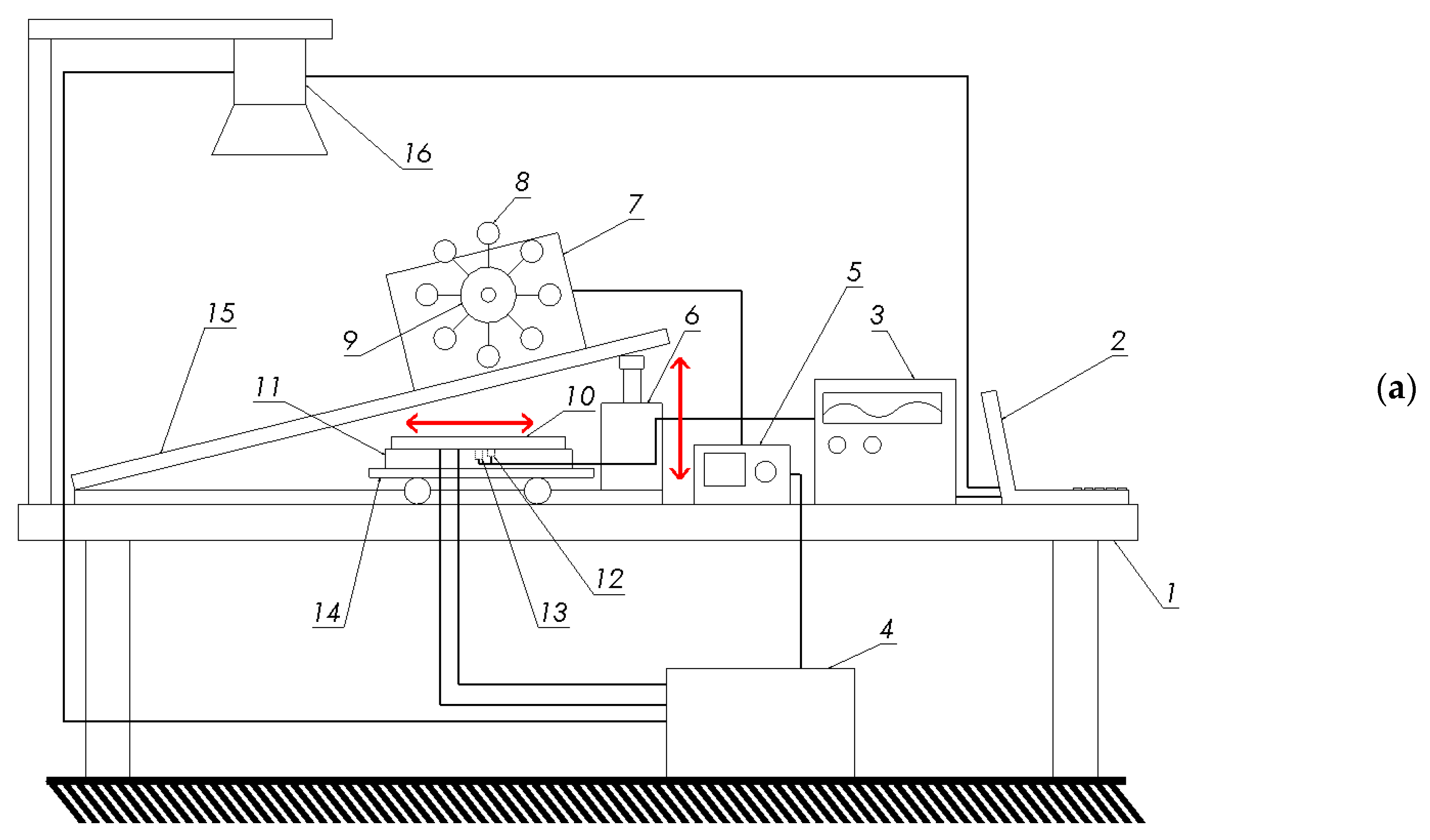
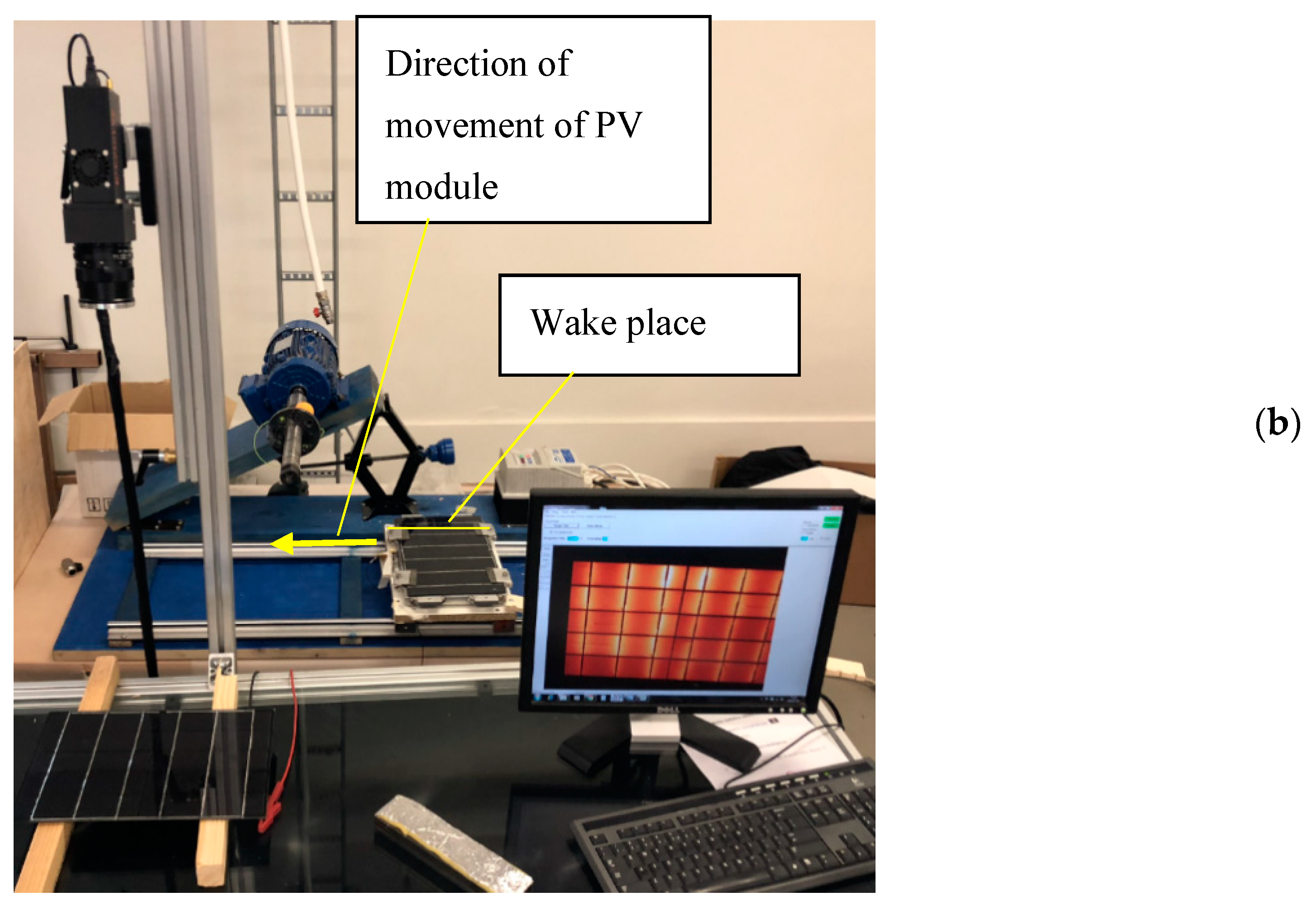
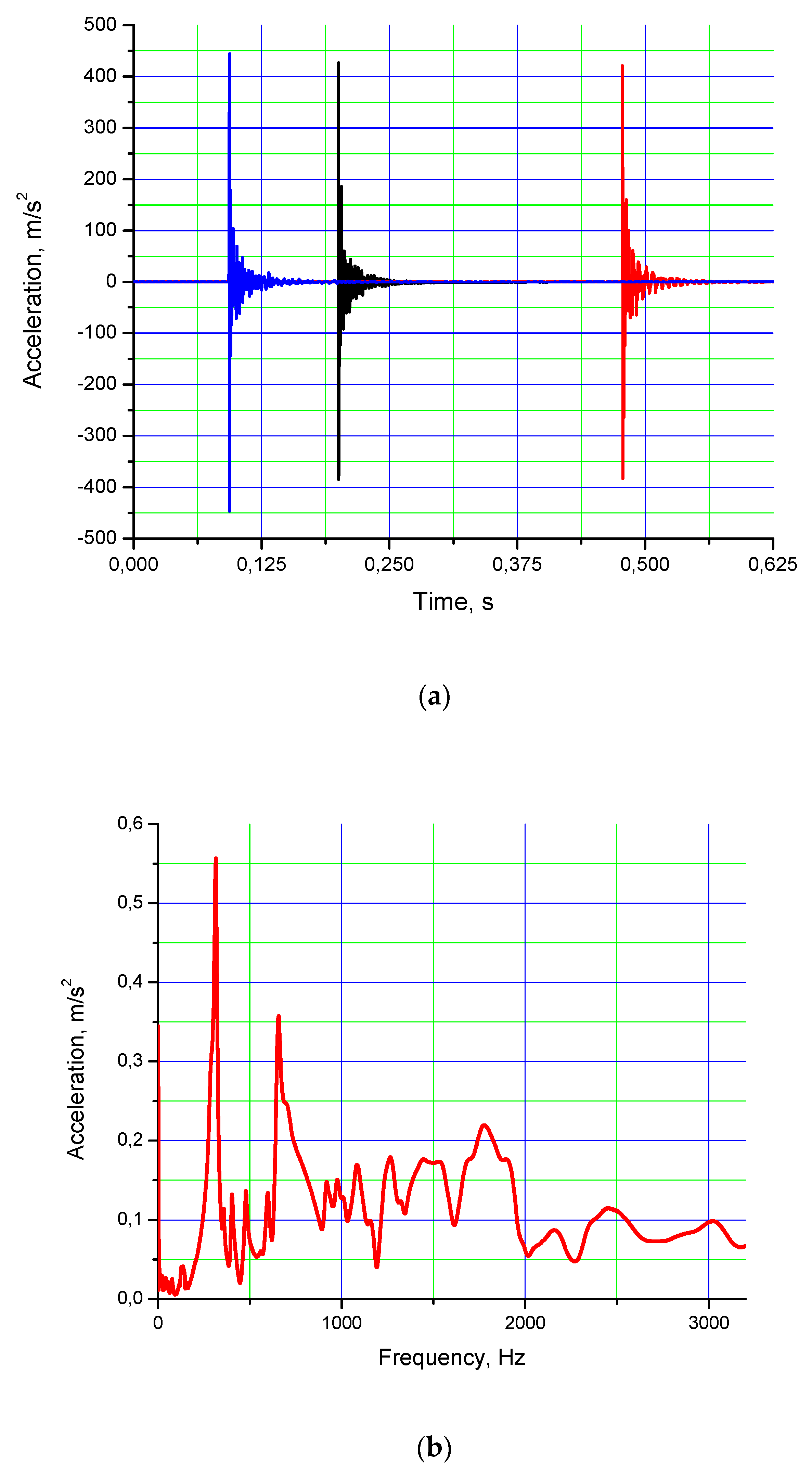
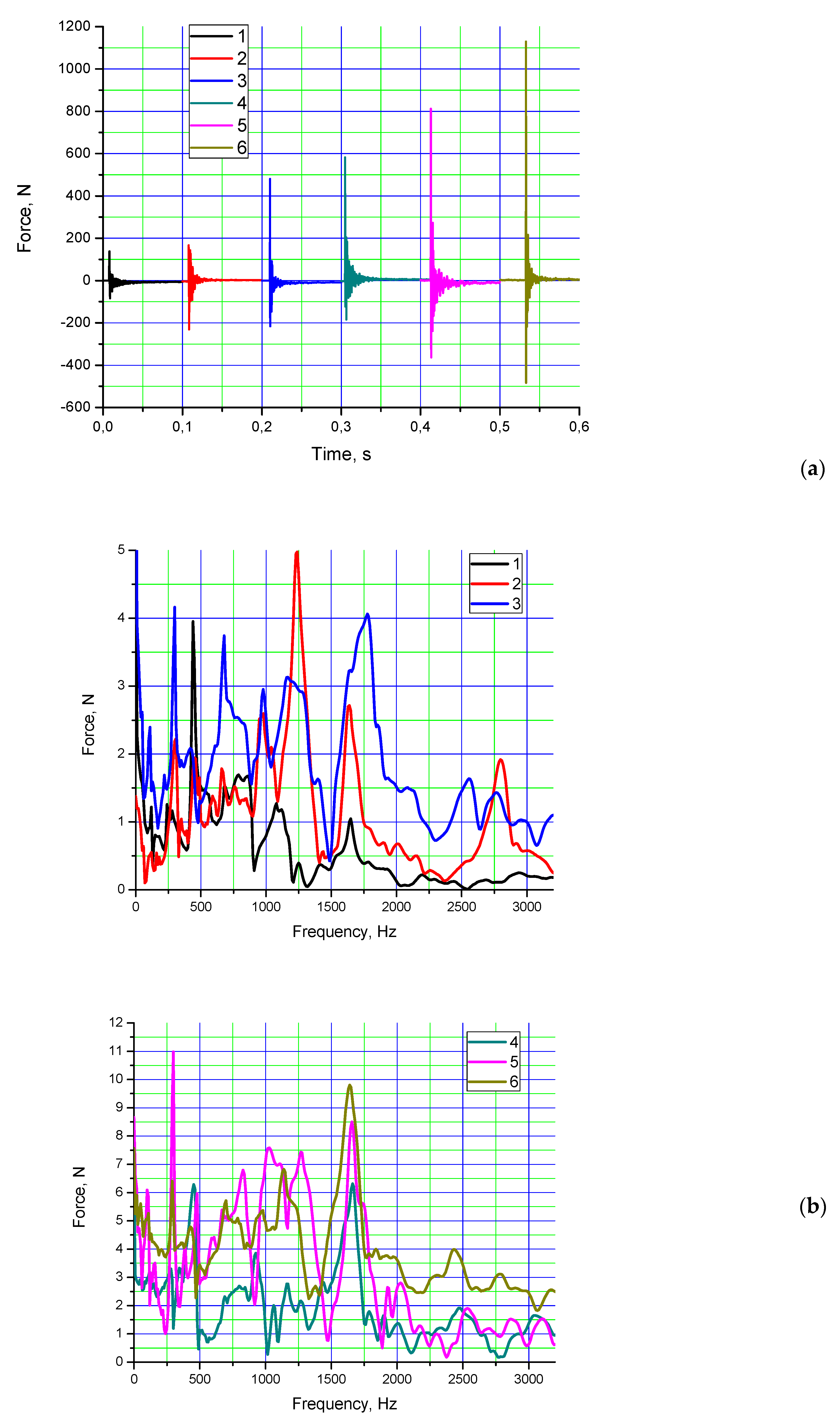
| Before Hail Simulation | After Hail Simulation | % | |
|---|---|---|---|
| The PV module 1 | |||
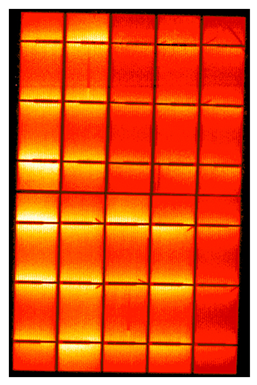 | 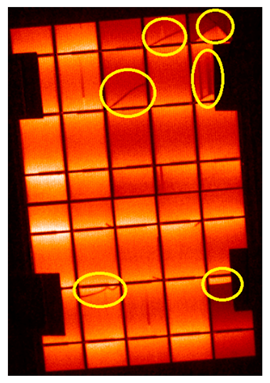 | 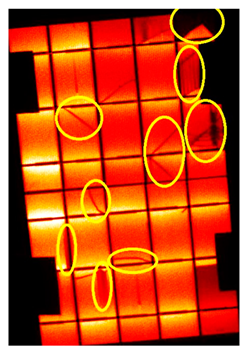 | |
| Power (W) | 9.720 | 8.914 | 8.29% |
| Voltage (V) | 5.227 | 5.257 | 0.57% |
| Current (A) | 1.860 | 1.695 | 8.87% |
| The PV module 2 | |||
 | 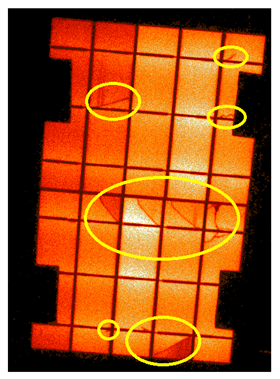 | ||
| Power (W) | 9.315 | 8.987 | 3.52% |
| Voltage (V) | 5.013 | 4.952 | 1.22% |
| Current (A) | 1.858 | 1.815 | 2.31% |
| The PV module 3 | |||
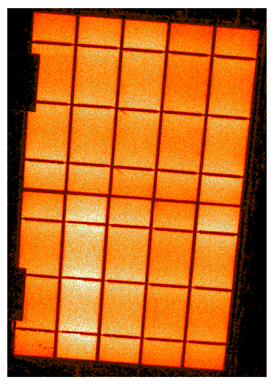 | 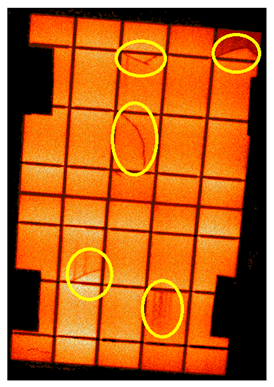 | ||
| Power (W) | 9.457 | 9.237 | 2.33% |
| Voltage (V) | 5.080 | 5.009 | 1.40% |
| Current (A) | 1.861 | 1.844 | 0.91% |
| The PV module 4 | |||
 |  | ||
| Power (W) | 9.461 | 9.125 | 3.55% |
| Voltage (V) | 5.064 | 4.966 | 1.94% |
| Current (A) | 1.868 | 1.837 | 1.66% |
| The PV module 5 | |||
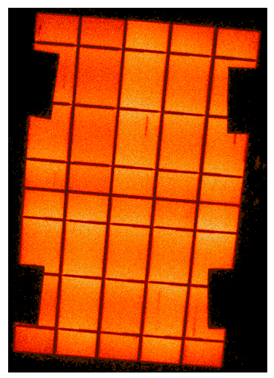 | 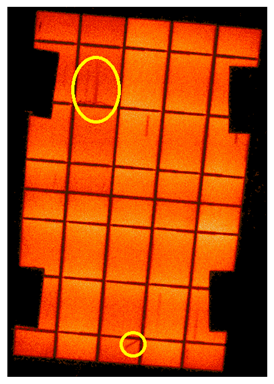 | ||
| Power (W) | 9.413 | 9.089 | 3.44% |
| Voltage (V) | 5.070 | 4.958 | 2.21% |
| Current (A) | 1.857 | 1.833 | 1.29% |
| The PV module 6 | |||
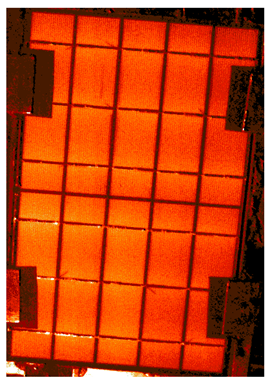 | 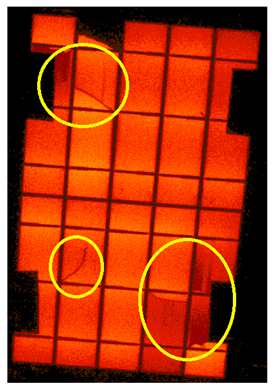 | ||
| Power (W) | 9.345 | 8.894 | 4.83% |
| Voltage (V) | 5.012 | 4.893 | 2.37% |
| Current (A) | 1.865 | 1.818 | 2.52% |
© 2019 by the authors. Licensee MDPI, Basel, Switzerland. This article is an open access article distributed under the terms and conditions of the Creative Commons Attribution (CC BY) license (http://creativecommons.org/licenses/by/4.0/).
Share and Cite
Kilikevičienė, K.; Matijošius, J.; Kilikevičius, A.; Jurevičius, M.; Makarskas, V.; Caban, J.; Marczuk, A. Research of the Energy Losses of Photovoltaic (PV) Modules after Hail Simulation Using a Newly-Created Testbed. Energies 2019, 12, 4537. https://doi.org/10.3390/en12234537
Kilikevičienė K, Matijošius J, Kilikevičius A, Jurevičius M, Makarskas V, Caban J, Marczuk A. Research of the Energy Losses of Photovoltaic (PV) Modules after Hail Simulation Using a Newly-Created Testbed. Energies. 2019; 12(23):4537. https://doi.org/10.3390/en12234537
Chicago/Turabian StyleKilikevičienė, Kristina, Jonas Matijošius, Artūras Kilikevičius, Mindaugas Jurevičius, Vytautas Makarskas, Jacek Caban, and Andrzej Marczuk. 2019. "Research of the Energy Losses of Photovoltaic (PV) Modules after Hail Simulation Using a Newly-Created Testbed" Energies 12, no. 23: 4537. https://doi.org/10.3390/en12234537
APA StyleKilikevičienė, K., Matijošius, J., Kilikevičius, A., Jurevičius, M., Makarskas, V., Caban, J., & Marczuk, A. (2019). Research of the Energy Losses of Photovoltaic (PV) Modules after Hail Simulation Using a Newly-Created Testbed. Energies, 12(23), 4537. https://doi.org/10.3390/en12234537








